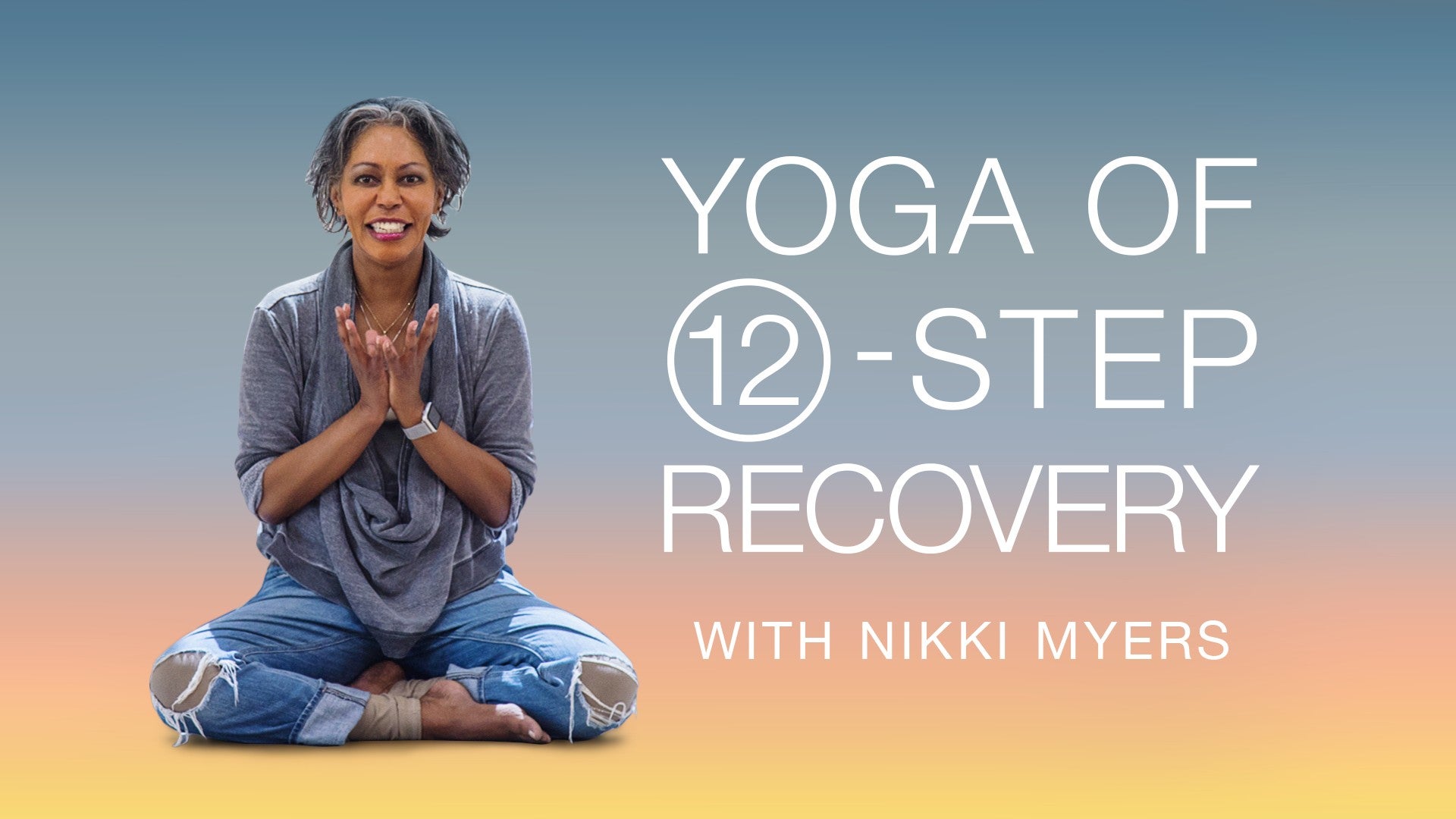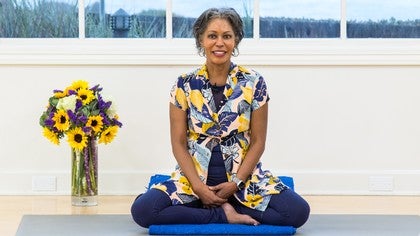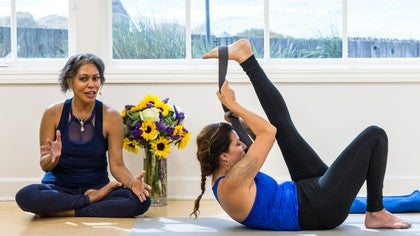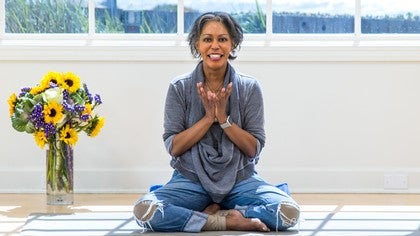Description
About This Video
Transcript
Read Full Transcript
Thank you. Welcome back. Welcome back. So, once our foundation is solid, that there is a sense of stability, a sense of steadiness, then we begin to recognize, now that our vessels back right side up, that the vessel's pretty dirty. There's a lot of mess in the vessel. In my case, I was in the water upside down for some 34 years. When that vessel got turned back right side up, I'm like, there's a lot of crap in here. So, this next set of steps in the 12-step program, as well as our work now at the level of soma, is about cleaning that vessel out and preparing it for sale. We want a sail-worthy vessel. So, this is about cleaning that vessel out and preparing it for sale. So, in the course of addiction, I collected habits. I collected patterns. Yogic speak for that again is samskara, these habits, these patterns, this conditioned way of thinking based on my addiction to the way I process my reality. So, these habits and patterns and conditioning gets formed, which I begin to discover have ultimately caused harm or hymseh, right? Hymseh in Sanskrit means violence or harm. I've ultimately caused harm to myself and to others. So, the 12-step program beautifully gives us a structured process by which we can really compassionately and with a little self-awareness begin to look at those patterns, begin to look at those habits in ways that we can assess which of these things serve what we say is most important to us and which of these things no longer don't serve what we say is most important to us. In the 12-step program, these are steps four through nine. Very often, they're called the action steps. And again, the way we work with this body in the body is just a little bit differently. We call it something a little bit different. We call it core, core. Now, very often, particularly in exercise physiology, when you think of core, a lot of times that's all of us, the muscles below the navel. We're referring to this in a much broader aspect when we speak about this in Y-12SR. Core is the pieces of us that we're bringing back home. We're bringing back in to coming back home to ourselves. Now, in our body, as I spoke to a little bit earlier, the general theme of Y-12SR is the issues live in our tissues. And what we work to do is release the issues that may be being held in our tissues. And gratefully, it's not really even necessary that we know what they are. The yoga practice gives us a way to release the issues in our tissues without necessarily having to reconnect it with a particular event or a particular action, if you will. In yoga, we work very deeply with connective tissue. An expanded view of connective tissue more than tendon or ligament. Those are definitely connective tissue. But going in a little bit deeper to the fascia, as a matter of fact, in neuroscience, whatever surrounds a cell is thought of as connective tissue. In yoga, we work with those energetic channels to release the issues that may be being held in our tissues. We use these practices to support a deeper level of determination, a deeper level of commitment, to build confidence, to give us the tools that we need when life gets hard, when life shows up, when life on life's terms happens. We need these tools. So we use the practices in order to build this level of commitment needed in order to do what can sometimes seem like the very, very difficult work of examining ourselves. Swadaya is this sense of deep self-reflection that a lot of times will seem like it's a very difficult task. I know for me, there was this sense of fear that what I was going to find after this examination was someone that was unlovable, someone that was flawed, someone that had all of many things wrong with them, that I was so unlovable and flawed. In fact, what I found after sorting through the chaos was a sense of who I really am, a sense of true nature. So the invitation here, once again, is to use the practices in order to build this sense of confidence, this sense of clarity, this sense of determination needed in order to undergo this process. With this set of steps, the action, the core steps, we begin to initiate this cleansing process. We take a look at what the obstacles may be.
We begin to get a sense of what our integrity, our values, our sense of actions are that either support us in what's most important to us or steer us away from what we consider to be most important to us. In this set of steps as well is where we begin the work of setting our relationships right. So a lot of times I've done this harm not only to myself but to others that I really and truly deeply love that are in my life. So we begin to do the work here to clear the energy to set our relationships right. And so again, this is a piece where we need the fortitude, where we need the commitment, where we need the clarity and self-confidence to undergo what can often seem like very, very difficult work. One of the yogic models that over the years I found very helpful in this process is the model given to us in the Upanishads known as the chakras. The chakras give us a way to look at programming that may have happened even from the point in time where we were very young children that actually affect what we're doing in our lives today. I know I found through some of this work that there were areas where 10-year-old Nikki was actually driving the bus for then 34-year-old Nikki. And looking at things through this model gave me a way to really look deeply at where that programming had actually begun to begin to dissolve the effect of that. So again, who was really making the decisions, who was really making the actions, where the actions were really coming from were from who I am in this moment versus living in the past and having that 10-year-old make decisions for me in my grown being right now. So the spiritual principles again that sit underneath these steps are patience, there's self-acceptance, a deep level of self-acceptance, there's compassion for both myself and for others, and forgiveness, and forgiveness. And again, these are all things that I can feel, a sense of feeling, there's a sense of sadness to this so that I can know whether I'm in them or I am not or I am out of them. And this is what we explore in the embodiment of these practices. And so just like earlier, in Mountain Pose, when we were speaking about the sense, the sensate sense of stability in the system, let's think about, for example, the spiritual principle of patience. One of the things that, or the phrases in the 12-step program again, you'll hear very often, is the wisdom to know the difference. Now we'll speak about this very specifically in our little mini-intervention a little later, but just to give us a sense for that and this spiritual principle of patience. Have you ever felt that sense of anxiety, that sense of, you know, just, rajasic is what it's called, that energy that just feels flighty and active in the system when, you know, you know again, you need something to get done, and it needs to get done right away, and you want it your way right now, right? That's a sense of impatience. That's for me, what impatience feels like in my body, right? The opposite of that is just kind of, I don't care what it is, and you know, it's a resigned, almost just feeling a sense of resignation in my body, which has even a bit of a contracted feeling in my body. In the middle of that, right? Right? The middle path, and in yoga we often talk about the middle path, right? Right in the middle of that there is a sense in the body where there just is a balance, a calm, a sense of knowing that whatever is, is what it is, that, you know, I know in that moment the wisdom to know the difference, right? I know what I can change, I know what I can't change, and right in that middle path, right there, is that sense of calm and peace and patience that is the wisdom to know the difference, and that feels in my body like a balance, like a calm, actually like the homeostasis. The homeostasis, the balance, which I think translates to yoga itself. The word yoga means balance, integration, right? So that place right there where there is that sense of balance and integration. That feels like patience in this body for me. And so in our mini-intervention we hope to give you some experience of that so you can feel it within your own body. Thank you so much for being here.
Yoga of 12-Step Recovery
Comments

You need to be a subscriber to post a comment.
Please Log In or Create an Account to start your free trial.







